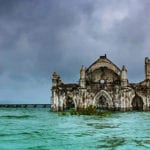 Technology
Technology  Technology
Technology  Humans
Humans 10 Everyday Human Behaviors That Are Actually Survival Instincts
 Animals
Animals 10 Animals That Humiliated and Harmed Historical Leaders
 History
History 10 Most Influential Protests in Modern History
 Creepy
Creepy 10 More Representations of Death from Myth, Legend, and Folktale
 Technology
Technology 10 Scientific Breakthroughs of 2025 That’ll Change Everything
 Our World
Our World 10 Ways Icelandic Culture Makes Other Countries Look Boring
 Misconceptions
Misconceptions 10 Common Misconceptions About the Victorian Era
 Mysteries
Mysteries 10 Strange Unexplained Mysteries of 2025
 Miscellaneous
Miscellaneous 10 of History’s Most Bell-Ringing Finishing Moves
 Technology
Technology Top 10 Everyday Tech Buzzwords That Hide a Darker Past
 Humans
Humans 10 Everyday Human Behaviors That Are Actually Survival Instincts
 Animals
Animals 10 Animals That Humiliated and Harmed Historical Leaders
Who's Behind Listverse?

Jamie Frater
Head Editor
Jamie founded Listverse due to an insatiable desire to share fascinating, obscure, and bizarre facts. He has been a guest speaker on numerous national radio and television stations and is a five time published author.
More About Us History
History 10 Most Influential Protests in Modern History
 Creepy
Creepy 10 More Representations of Death from Myth, Legend, and Folktale
 Technology
Technology 10 Scientific Breakthroughs of 2025 That’ll Change Everything
 Our World
Our World 10 Ways Icelandic Culture Makes Other Countries Look Boring
 Misconceptions
Misconceptions 10 Common Misconceptions About the Victorian Era
 Mysteries
Mysteries 10 Strange Unexplained Mysteries of 2025
 Miscellaneous
Miscellaneous 10 of History’s Most Bell-Ringing Finishing Moves
10 Destinations with a Troubling History of Disappearances
There are certain places in the world where you don’t necessarily have to have been there yourself to know what to expect. Disney World, for example, brings to most minds a childlike exuberance that defies age and circumstance. You also don’t need to set foot on Paradise Beach in Mykonos to know that it offers sun, sand, and a party atmosphere. A lot of landmarks around the world have a similar sort of effect. When you make the trip, you find it is just how you imagined it.
This effect also applies to locales with negative associations, whether connected to human suffering, natural disasters, or other tragic or even supernatural events. For instance, it may be hard to set sail on a cruise on the North Atlantic Ocean without remembering the RMS Titanic. You might also feel inclined to watch for the Mothman if you head to Point Pleasant, West Virginia, or scan the snow line for Yetis in the Himalayas.
Some other areas are attached to something even more sinister: unexplained disappearances. Whether an ongoing phenomenon, a one-time mass disappearance, or other mysterious circumstances, many places on Earth are known to be where people go missing. Check out these 10 locations on land and sea with a long and unsettling history of disappearing acts.
Related: 10 Expeditions That Mysteriously Disappeared
10 Suvla Bay
Sulva Bay is on the Aegean coast of the Gallipoli peninsula in Eastern Turkey. It is home to hundreds of shipwrecks, with 216 occurring between April 1915 and January 1916 alone. But even more concerning is the bizarre weather phenomenon that resulted in a mass disappearance. In August 1915, an entire battalion of soldiers vanished after walking into a strange-looking cloud.
Onlookers reported seeing a large, silvery cloud slowly engulf a British colonel, 16 officers, and 250 soldiers in a forest near the coast. Eventually, the cloud rose and joined with several others before moving against a strong wind and disappearing from view. Later, 180 bodies were found scattered over one square mile (2.6 square kilometers) near a small farm. A witness said it looked like they fell from a great height.
There is still no explanation for the deaths or missing men, but UFOs, a portal to a parallel universe, and secret chemical weapons are among the more sensational theories. Others include a silent, unseen battle between Turkish and British soldiers or the soldiers mistakenly attacking their own.[1]
9 The Sargasso Sea
The Sargasso Sea is a one-of-a-kind spot. In the middle of the North Atlantic Ocean, it is the only sea without a shoreline. Sargasso is bounded by four currents, forming an ocean gyre (a circular or spiral ocean current). Huge mats of Sargassum seaweeds cover roughly 1/3 of the water’s surface, and the Bermuda Triangle sits near its western fringes.
This unique sea also has a nasty habit of robbing sailing boats of their crews. “Graveyard of Ships” and “Sea of the Lost Ships” are some of the nicknames that have resulted from hundreds of stories of phantom ghost ships that have wandered its waters.
The best-known examples are the French ship Rosalie, the American schooner Ellen Austin, and the SS Connemara IV. Many other unnamed boats and yachts have also been found drifting solo between the 1960s and 1980s. There are even a few stories of ships found with the skeletal remains of their crew members. Many of these disappearances and deaths remain unexplained.[2]
8 The Flannan Isles
The Flannan Isles are a group of seven rocky and uninhabited islands in Scotland. In 1899, a lighthouse was built on the highest hill on the largest island, Eilean More. Before the year was over, three of its lighthouse keepers disappeared.
On December 7, 1900, Donald MacArthur, Thomas Marshall, and James Ducat began what was to be a two-week rotation as keepers of the lighthouse. The Superintendent of Lighthouses, Robert Muirhead, was the last to see them alive when he performed a routine check. The lighthouse was also monitored by a telescope from the mainland, allowing the men to signal for help if needed. But, a heavy mist surrounding the island made that a problem.
The lighthouse was visible on December 7th and 12th, but a passing ship reported that the light was off on the 15th. It was not seen again until the 29th, eight days after the men should have ended their rotation. Their relief arrived late due to bad weather and found that a clock had stopped, no fire was burning, and a meal was sitting on the table, untouched. But the men were gone. They were never seen again and left only theories behind.[3]
7 Lake Anjikuni
Lake Anjikuni is a remote, inhospitable lake in the Northern Territories of Canada. Covered with ice and snow for half the year, it forms part of a string of waterways that one of the historical communities, known as the Inuit, used for fishing and trade.
In November 1930, a fur trapper named Joe Labelle passed through a small Inuit community near Anjikuni Lake and found that all its inhabitants were gone. There was no evidence of foul play, but it was clear that something had happened, and it had happened quickly. Food hung over fire pits, projects were left half-finished, and seven sled dogs tied to posts had starved to death. Labelle also noticed an exhumed grave, saying it appeared to have been done by a human rather than an animal.
Labelle reported his findings to the North-West Mounted Police. The police found that the Inuit had been missing for eight weeks before Labelle’s visit but could not locate them or uncover what had happened. Adding to the mystery, officers reported seeing blue, unnatural pulsing lights over Lake Anjikuni. These were never explained but may have inspired the most popular theory behind the Inuit’s disappearance: UFOs.[4]
6 Pecos, New Mexico
Pecos, New Mexico, is located just outside Santa Fe and boasts some of the most scenic terrain in the state. It is also known for a string of mysterious disappearances, earning it the unofficial title: “The New Bermuda Triangle.” Emma Tresp and Mel Haldel are two of the most recent disappearances.
In 1998, Emma Tresp took a wrong turn on her way to a monastery for a religious retreat in Pecos. Her car became damaged by a large rock in the notoriously rough Forest Road 375 in the Santa Fe National Forest, known by some as “The Devil’s Road.” Leaving most of her belongings in the locked car, it appeared Emma went off on foot to search for help. But her footprints only circled her car without leading off in any direction, and search dogs were unable to pick up her scent anywhere besides by the vehicle.
The location was only about 5 miles (8 kilometers) from where Mel Haldel disappeared in 2009 after getting separated from his hunting party. Like Emma, Mel’s footprints presented a baffling mystery by coming to an abrupt stop, making it appear he had vanished into thin air.[5]
5 The Devil’s Sea
The Devil’s Sea, also known as the “Dragon’s Triangle,” is located near the Japanese coast in the Pacific Ocean, extending between Japan and the islands of Bonin, including most of the Philippine Sea. It isn’t represented on the map, so the exact perimeter and size are unknown and are often a subject of debate. The Devil’s Sea is one of twelve vile vortices on Earth, defined as areas where the pull of the planet’s electromagnetic waves is stronger than anywhere else. It also hosts unique geographical features like undersea volcanoes and methane hydrates on the seabed.
In addition to missing planes, submarines, and even islands, the Devil’s Sea has gained attention for the surprisingly large number of vanished ships. Legends say the waters are “notorious for making even the strongest vessels disappear, along with the crew….” The research ship Kaio Maru No. 5 was sent in search of the missing vessels in 1952, only to suffer the same fate. Ancient sea creatures, black holes, and time warps are some theories that attempt to explain the strange occurrences.[6]
4 Roanoke Island
Roanoke Island rests along the Outer Banks off the coast of North Carolina. It is one of the smaller islands and currently spans approximately 8 miles (12.9 kilometers) long and 2 miles (3.2 kilometers) wide, with towering pine trees, marshlands, and other unique scenery. Roanoke was England’s first colony in America and the scene of the “biggest unsolved mystery in American history.”
In August 1587, John White, governor of the Roanoke Island colony, sailed to England to gather supplies and reinforcements for the 115 colonists struggling to adapt to the unfamiliar landscape. The Spanish Armada delayed his return until August 1590, when he found the colony abandoned. The only clue left behind was the words “CROATOAN” carved on a palisade post and “CRO” carved on a tree.
No one knows what happened to the colonists to this day. Roanoke Island has suffered from extensive erosion over the past 400 years, so the remains of the colony may now be underwater.[7]
3 Pyramid Lake
As one of the largest natural lakes in Nevada, Pyramid Lake covers an impressive 125,000 acres (50,586 hectares). It is surrounded by many unique rock formations, with a large pyramid-shaped one in the lake that inspired its name. Despite its beauty, Pyramid Lake has a dark history that some believe led to several disappearances. The lake saw one of the bloodiest battles between the Native Americans and white settlers in the state when the local Paiute tribe joined with the Shoshones and Bannocks. Together, they killed more settlers than ever before.
The Paiute tribe had long believed that Pyramid Lake was cursed. According to one legend, a mermaid from the lake fell in love with a tribesman, but his family disapproved of their union. Furious, she cursed the lake and everyone who lives around it. Another legend involves demons who appear as baby-like creatures known as “Water-Babies.” They are said to haunt the lake just under the surface, waiting to pull unsuspecting fishermen in. Visitors report hearing the sounds of crying children on the water during the spring, which happens to be the same time of year that most boating accidents occur.
These legends are often referenced anytime swimmers, scuba divers, or boaters disappear in the lake under strange circumstances. In many cases, the bodies are never recovered. Some have been found in Lake Tahoe, even though they drowned in Pyramid Lake.[8]
2 Superstition Mountains
The Superstition Mountains, east of Phoenix, Arizona, are well known for being the resting place of the Lost Dutchman’s treasure. It is also home to unfriendly wildlife, sheer drop-offs, deep canyons, and wild swings in temperature. Not to mention the many mysterious disappearances, strange sounds, and unexplained deaths that gave it its name: superstition. More hikers disappear in the Superstitions than in any other mountain range, claims George Johnston, president emeritus of the Superstition Mountain Museum. The average is 4-5 hikers per year.
Two such hikers were Adolf Ruth and James A. Cravey. Treasure hunter Adolf Ruth acquired maps to old mines, convinced that one of them would lead him to the Lost Dutchman’s treasure. Instead, they led to his disappearance and death. A message in a bottle revealed that Ruth had broken his leg and needed help (but hinted he had found the treasure before becoming injured). In December 1932, a bullet hole was discovered in his skull—a mile from the rest of his body. Similarly, in 1947, the headless body of a prospector named James A. Cravey was found tied up in a blanket while his head was 30 feet (9.1 meters) away.
The men’s deaths only fueled public interest in the treasure, adding more names to the list of disappearances and deaths.[9]
1 Yosemite National Park
National parks are notorious for disappearances, and Yosemite might be where it happens the most. And the numbers are only rising. Located about 140 miles east of San Francisco and 100 miles (161 kilometers) southeast of Sacramento in California, this national park’s recent uptick in missing person cases could be due to increased popularity or a sign that it is becoming more dangerous. Either way, more than 700 cases have been reported in the park since the first-ever disappearance in 1851.
One case involved the famous photographer Ansel Adams, who vanished in the park in 1928 without a trace. There is also a disturbing trend with children going missing in the park. The most well-known case was 14-year-old Stacey Arnas, who mysteriously disappeared while camping with her family on July 25, 1981. Some attribute these and other disappearances to legends surrounding the land, including ancient Native American curses and supernatural beings- such as Nightcrawlers, Wendigos, and Seeahtiks—as well as Bigfoot, evil spirits, and the ghosts of those who died in the park.[10]








